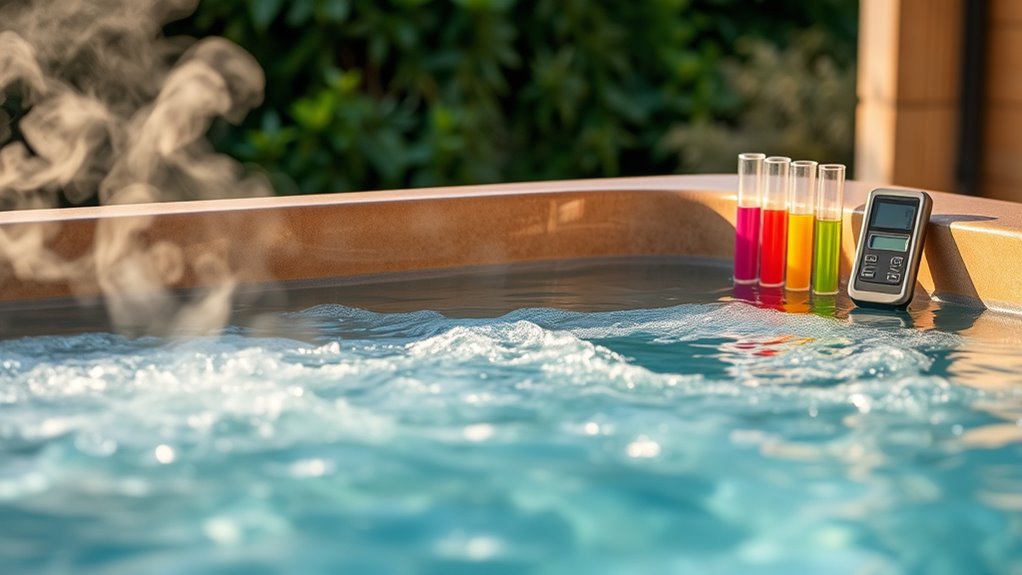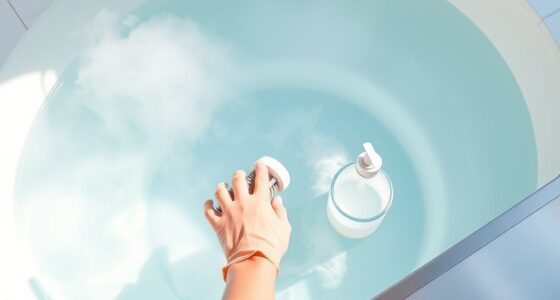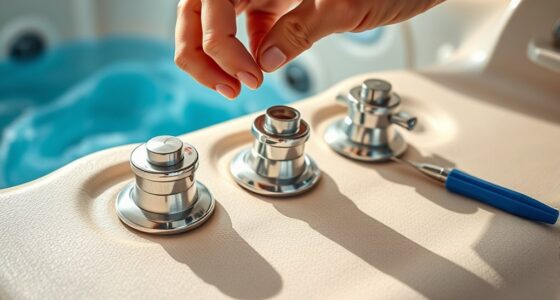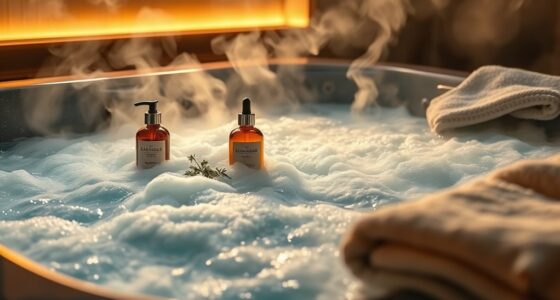To keep your hot tub water safe and clean, you need to manage sanitizer levels, adjust pH between 7.2 and 7.8, and balance alkalinity from 80-120 ppm. Regular testing helps catch issues early, while controlling cloudiness involves cleaning filters and shocking the water when needed. Maintaining proper chemistry guarantees a comfortable, healthy soak. Keep exploring to learn how to fine-tune these aspects for pristine hot tub water.
Key Takeaways
- Regularly monitor and adjust pH levels to keep them between 7.2 and 7.8 for comfort and safety.
- Use sanitizers like chlorine or bromine to eliminate bacteria, viruses, and prevent algae growth.
- Maintain proper alkalinity (80-120 ppm) to stabilize pH and prevent water issues.
- Check water clarity regularly and address cloudiness by balancing chemistry and cleaning filters.
- Conduct weekly tests and routine maintenance, including filter cleaning and water refilling, to ensure healthy hot tub water.
Understanding the Role of Sanitizers
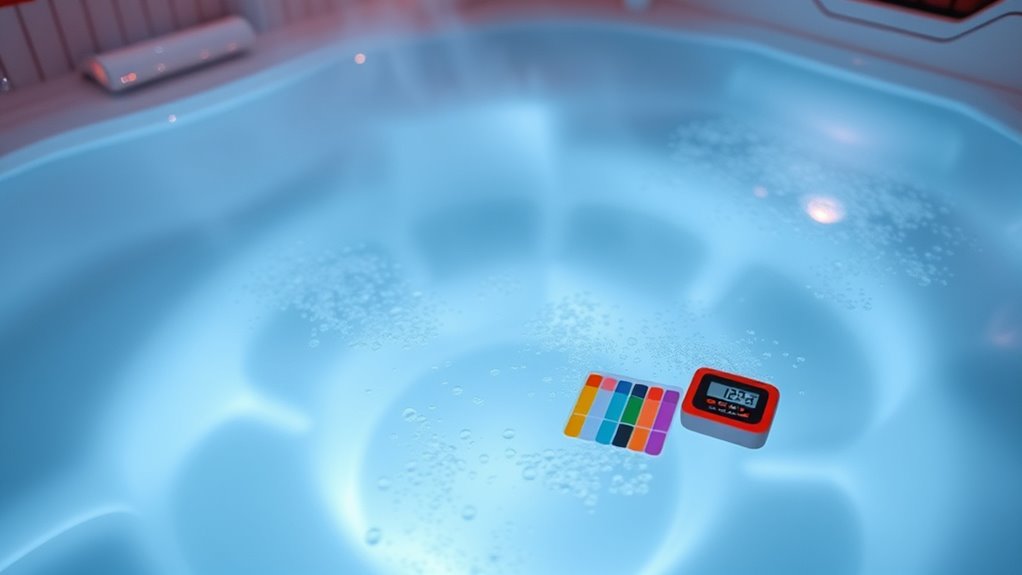
Sanitizers play a crucial role in keeping your hot tub water clean and safe. They eliminate bacteria, viruses, and other harmful microorganisms that can cause infections or unpleasant odors. Without proper sanitization, algae and biofilm can grow, making your hot tub unappealing and unsafe. Common sanitizers like chlorine and bromine are effective because they quickly neutralize contaminants. They also help break down organic matter introduced through bathers. When you add sanitizer regularly, you maintain a consistent level that prevents the buildup of germs. This not only keeps your water clear and inviting but also protects your skin and health. Proper sanitizer levels are essential for a safe, hygienic hot tub experience, especially considering the importance of water chemistry in overall water quality.
Monitoring and Adjusting Ph Levels

Maintaining proper water chemistry involves more than just adding sanitizers; it also requires monitoring and adjusting pH levels regularly. When your pH is off, your hot tub’s water can become corrosive or scale-forming, leading to uncomfortable experiences and costly repairs. You’ll want to keep the pH between 7.2 and 7.8 for ideal comfort and safety. To do this, check the pH with a test strip or digital tester weekly. If it’s too low, add pH increaser; if it’s too high, use a pH reducer. Regular adjustments help prevent skin irritation, protect your equipment, and keep your hot tub inviting. Incorporating data-driven strategies can also enhance your water chemistry maintenance by providing more precise and timely information. AI-powered automation’s role in business intelligence can also assist in monitoring water chemistry data for more precise maintenance. Implementing smart monitoring tools allows for real-time tracking of water parameters, leading to better overall control. Additionally, understanding the impact of automation on efficiency can help you optimize your water management routine. For example, utilizing automated testing systems can help maintain consistent water quality without manual oversight. Feel confident in your ability to maintain clean, balanced water – Enjoy soothing, irritation-free soaks – Protect your investment from costly damage – Feel proud of your hot tub maintenance skills
Balancing Total Alkalinity

Balancing total alkalinity is essential for maintaining stable pH levels and ensuring comfortable, clear water in your hot tub. When alkalinity is too low, the pH can fluctuate wildly, causing irritation and corrosion. If it’s too high, the water becomes cloudy and pH becomes difficult to adjust. To test alkalinity, use test strips or a liquid test kit, and aim for a range of 80-120 ppm. If levels are off, add an alkalinity increaser or decreaser as needed, following the product instructions carefully. Always make adjustments gradually, retesting after each addition. Proper alkalinity equilibrium helps prevent pH swings, protects your hot tub equipment, and keeps your water inviting and safe for soaking. Regular testing and adjustment are key to optimal water chemistry and maintaining a healthy hot tub environment. Understanding water chemistry is crucial for balancing chemicals and ensuring your hot tub remains safe and enjoyable. Maintaining proper alkalinity also helps prevent corrosion and scaling, which can damage your hot tub components over time.
Recognizing and Controlling Water Cloudiness

When alkalinity levels are out of balance, water can quickly become cloudy, signaling trouble beneath the surface. Cloudiness often indicates imbalanced pH, excess debris, or inadequate filtration. Recognizing this visual cue helps you catch problems early before they worsen.
Cloudy water signals pH imbalance, debris buildup, or filtration issues needing prompt attention.
To control cloudiness:
- Regularly check and adjust alkalinity and pH levels to prevent mineral buildup.
- Maintain proper filtration, running your hot tub long enough to clear debris.
- Shock the water periodically to eliminate organic contaminants.
- Clean filters thoroughly to remove oils, dirt, and biofilms that cause murkiness.
Taking swift action keeps your water clear, inviting, and safe. Cloudy water isn’t just unsightly—it signals your hot tub needs attention to protect your comfort and health.
Regular Testing and Maintenance Practices

Regular testing and maintenance are essential to keep your hot tub water safe and inviting. You should test your water at least once a week using test strips or a testing kit to check pH, alkalinity, and sanitizer levels. Keeping these balanced prevents issues like cloudiness, corrosion, or bacteria growth. Make it a habit to clean your filters regularly, ideally every 1-2 months, to ensure proper water flow and filtration. Drain and refill your hot tub every 3 to 4 months, or more often if needed, to prevent buildup of contaminants. Always follow the manufacturer’s instructions for chemical additions, and keep a record of your tests and maintenance schedule. Proper water chemistry management is crucial for maintaining a safe and comfortable hot tub environment. Consistent care helps maintain clear, healthy water and prolongs the life of your hot tub. Additionally, monitoring your water chemistry levels closely can help you identify and address imbalances before they lead to bigger problems.
Frequently Asked Questions
How Often Should I Change My Hot Tub Water Entirely?
Did you know that most hot tub owners change their water every 3 to 4 months? You should do the same to keep your hot tub clean and safe. Regular water changes prevent bacteria buildup and maintain proper chemical balance. If you notice cloudy water, strong odors, or skin irritation, it’s time for a full drain and refill. Proper maintenance guarantees a relaxing, healthy soak every time.
What Are Natural Alternatives to Chemical Sanitizers?
You want natural alternatives to chemical sanitizers, and there are some options you can try. You might consider mineral sanitizers, like silver and copper ions, which help keep bacteria at bay. UV sterilizers and ozone generators are also effective since they use light and ozone to disinfect water without chemicals. Regularly cleaning your hot tub and maintaining proper pH levels also reduce bacteria naturally, making your soak safer.
Can I Use Household Products to Treat Hot Tub Water?
Imagine your hot tub as a delicate dance floor, craving balance and harmony. Using household products might seem tempting, but it’s like trying to tame wild horses—unpredictable and risky. Household items can throw off your water’s rhythm, causing cloudiness or bacteria buildup. Stick to proper sanitizers designed for hot tubs; they’re your choreographers, ensuring your soak stays safe, clear, and inviting, like a perfectly choreographed ballet.
How Does Hard Water Affect Hot Tub Water Chemistry?
Hard water impacts your hot tub by introducing excess minerals like calcium and magnesium, which can cause cloudiness, scale buildup, and clog filters. These minerals interfere with sanitizer effectiveness and can lead to cloudy water or scale deposits on surfaces. To prevent issues, you should regularly test your water, use a water softener if needed, and rinse your hot tub surfaces thoroughly to keep the water balanced and clear.
What Are Signs of Chemical Imbalance Before Testing Kits Indicate?
You might notice signs of chemical imbalance before testing kits show it. Your hot tub water could look cloudy or murky, and there might be a strong chemical smell. You could also feel skin irritation or see foaming on the surface. If you notice these issues, it’s a good idea to test the water promptly. Addressing these signs early helps keep your hot tub safe, clean, and comfortable for use.
Conclusion
Mastering your hot tub’s water chemistry is like tending to a delicate garden—you nurture it with care, and it blooms with crystal-clear beauty. When you understand sanitizers, pH, alkalinity, and clarity, you create a soothing oasis that welcomes relaxation and peace. Keep testing and adjusting, and your hot tub becomes a sparkling sanctuary, reflecting your dedication and love. With each careful step, you transform simple water into a haven of tranquility and joy.
